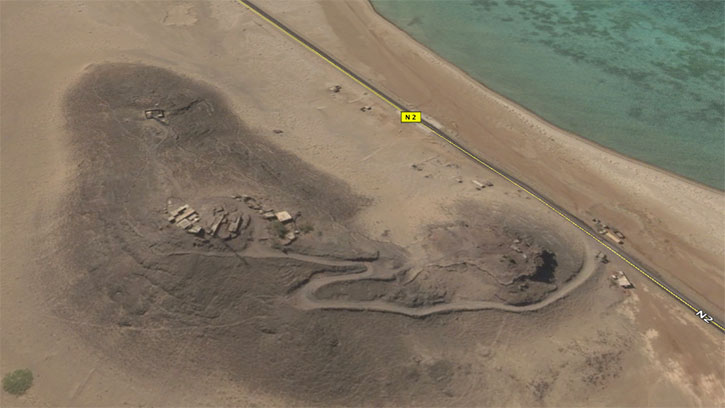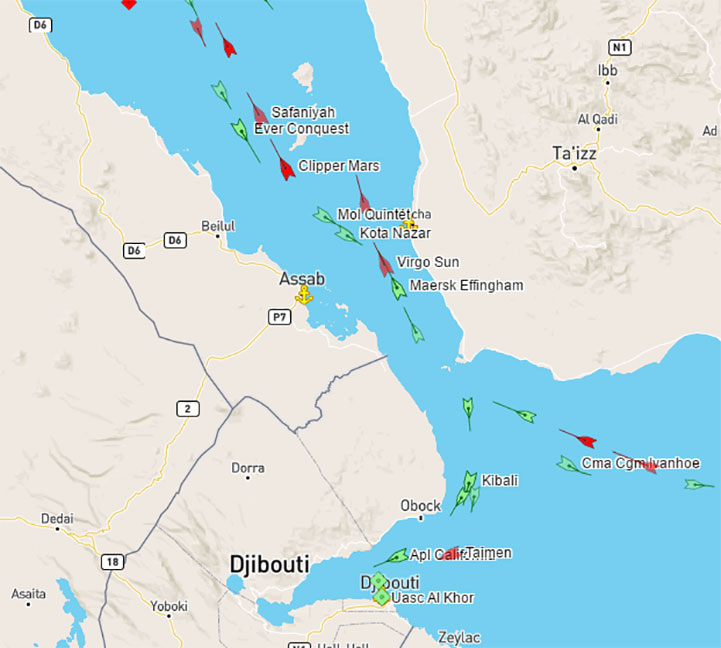
A US Navy guided missile destroyer launched a salvo of Tomahawk cruise missiles against three Yemeni radar sites along the red sea shoreline, in response to recent attacks on U.S. ships in the region. The targets were in Dhubab, north of Bab-el-Mandeb and in Ras Isa, north of Mukha and Khoka, near the Red Sea port of Al Hudaydah. Both locations were involved in recent attacks on US naval ships.

These radars are also thought to have been involved in the recent attack on merchant ships that operate in the area. Iran-backed Houthi forces that currently dominate Yemen’s Red Sea coast north of Bab-el-Mandeb have repeatedly threatened attacks against ships in their ‘territorial waters’.
First attacks against Saudi vessels were first reported in October 2015 as Houthis claimed to damage or destroy two Saudi naval vessels, but such attacks were not confirmed since. A year later, on the night of October 2, 2016, the Houthi launched a missile that targeted the USA-flagged (ex-US Navy Catamaran) Swift, leased by the UAE to provide logistical support in the area. The devastating attack set the boat on fire. UAE sources did not reveal how many crew members were injured, nor whether there were any fatalities. The weapon that attacked the vessel was identified as the C-802 coastal anti-ship missile supplied to the Huthis by Iran.
The UAE Ministry of Foreign Affairs and International Cooperation says that the ship was targeted by the Houthi and Saleh militias off the coast of Mocha, Yemen, when carrying assistance, wounded Yemenis, and passengers. The statement said that the crew of the ship comprises 24 civilians of six nationalities: 10 Indians, seven Ukrainians, four Egyptians, and three from Jordan, the Philippines, and Lithuania. The ministry said that the ship, which is unarmed and has no military protection, was passing through the Bab-al-Mandab Strait like any other civilian and commercial ship. It has been conducting routine trips to Aden for one year and all its crew members are civilians.

In response, and as a measure to protect international shipping lane in the area, the US Navy deployed three ships to Bab-el-Mandeb – the guided-missile destroyers USS Nitze (DDG-94) and USS Mason (DDG-87) and the afloat forward staging base USS Ponce (AFSB(I)-15). The two destroyers are assigned to the Dwight D. Eisenhower carrier strike group operating in the region. The Ponce is supporting special operations in the area and is also equipped with an experimental laser designed to counter threats from small, fast boats and UAVs.

The appearance of the US ships did not deter the Houthis, as missile attacks were repeated on Sunday and Wednesday this week, this time directly targeting the US forces – the Mason and the Ponce. These attacks were also identified a C-802.
The Mason launched three Standard Missile 2 (SM-2) and Evolved Sea-Sparrow Missile (ESSM) anti-air missiles against the first Houthi missiles, to protect itself and the nearby Ponce. This event was the first combat use of the ESSM. The Mason also employed electronic countermeasures and decoys against the incoming radar-guided missiles, including the Nulka off-board anti-ship missile decoys. Both Yemeni missiles struck the water at a distance from the defended ships, causing no damage.
Four days after the first attack, the Houthis launched another attack against the Mason, with two more anti-ship missiles. This attack happened off the southern city of Al Hudaydah, at around 18:00 local time. The Mason fired defensive missile salvos against the incoming threats, which have brought down at least one of the incoming missile.
The US response came hours later, with a barrage of Tomahawk Land Attack Missiles (TLAM) launched by USS Nitze (DDG-94) around 04:00 local time. “Initial assessments indicate that all three targets were destroyed,” the statement said. Pentagon sources reported that these radars were active during the previous attacks on ships in the red sea.
Update: Missile attacks on the Mason continues on October 15th, few days after the US retaliation.
The Pentagon refrained from addressing the cruise missile strikes as retaliatory or an act of deterrence and described the attacks authorized by President Barrack Obama it as ‘limited self-defense actions’ conducted to protect our personnel, our ships and our freedom of navigation in this important maritime passageway’ Pentagon spokesman Peter Cook said.
The American attack triggered a quick reaction from Iranian, with the announcement of the dispatch of the ‘Iranian Navy 44th fleet’, comprised of the Saam class frigate Alvand (INS 71) and logistics combat vessel Bushehr (INS 422). While the mission is part of a routine deployment the Idranian maintains in the East Indian Ocean, the announcement came only few hours after the US attack is considered as an Iranian response to the military act.
a. According to the Iranian news agency Tasnim, the vessels were sent to the Gulf of Aden and the Bab-el-Mandeb Strait on October 13, few hours following the US attack. However, the mission has been planned in advance, as part of a long-range patrol along the East African coast, from Somalia to South Africa. In previous missions, the Iranian flotilla patrolled the Red Sea and made port calls in Sudan. The Alvand is armed with four launchers of C-802 anti-ship while Bushehr has a large rear deck supporting helicopter operations.
The Chinese C-802 anti-ship missile also known in Iran as ‘Noor’ was supplied to Iran by China. It is an offshoot from the French Exocet anti-ship weapon, improved by the Chinese. The weapon has already been delivered to several conflict areas, including Syria and Lebanon, where it was used against the Israel Navy Corvette INS Hanit in 2006. During this strike, the Hanit was damaged by one missile, while another hit and sunk the Cambodian-registered merchant ship MV. Moonlight about 50 km off the shore.




















